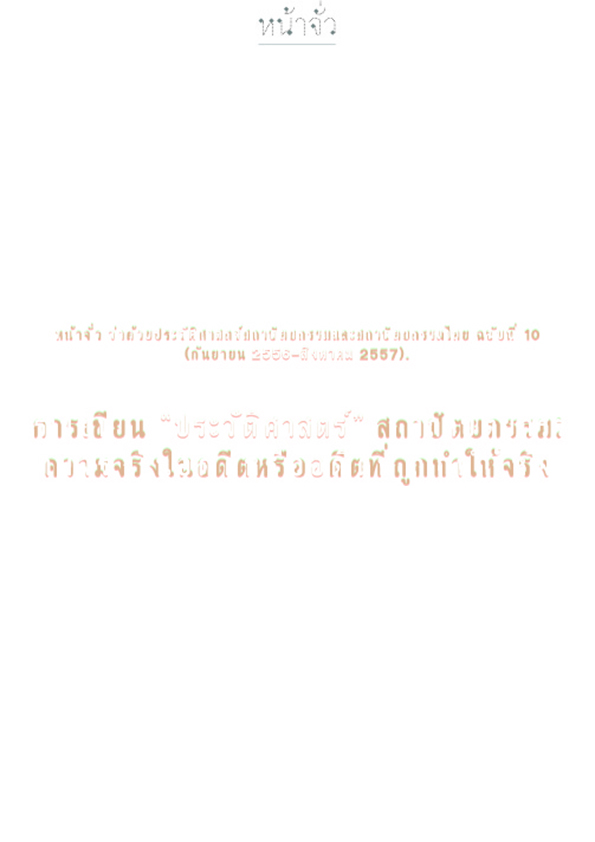ความสะอาดของพระนคร: การเมืองเรื่องวิถีปลงศพในสมัยรัชกาลที่ห้า Cleanliness in Bangkok : The Politics of Dead Bodies Disposal of the Fifth Reign
Main Article Content
Abstract
บทคัดย่อ
ในรัชสมัยของพระบาทสมเด็จพระจุลจอมเกล้าเจ้าอยู่หัว รัฐบาลสยามเริ่มการปฏิรูปด้านสุขอนามัย โดยมีวัตถุประสงค์เพื่อปฏิรูปกรุงเทพฯ และแก้ไขปัญหาอันเกิดจากการเจริญเติบโตอย่างรวดเร็วของเมือง ซึ่งปัญหาดังกล่าวคล้ายคลึงกับสิ่งที่เกิดขึ้นในกรุงลอนดอนและปารีสสมัยกลางคริสต์ศตวรรษที่ 19
พระบาทสมเด็จพระจุลจอมเกล้าเจ้าอยู่หัวทรงปรารถนาที่จะเปลี่ยนแปลงวิถีชีวิตบางประการของชาวสยามในพระนคร เมื่อพระองค์ทรงเห็นว่าวิถีชีวิตนั้นก่อให้เกิดภาพลักษณ์ที่ไม่ดีงาม ดังจะเห็นได้จากพระราโชบายในการสร้างห้องสุขาสาธารณะทั่วกรุงเทพฯ การนำเข้าเตาเผาศพไฟฟ้า การประกาศกฎหมายใหม่อันเกี่ยวเนื่องกับการสาธารณสุขและสุขอนามัยบริเวณริมแม่น้ำ ลำคลอง และถนนตัดใหม่สายสำคัญของกรุงเทพฯ รวมถึงการยกเลิกประเพณีทิ้งซากศพให้แร้งจิกกิน ณ เมรุแร้งวัดสระเกศ เนื่องจากวิถีการปลงศพเช่นนี้เปรียบเสมือนคำปรามาสต่อการปฏิรูปของพระองค์
ช่วงเวลานั้น ชาวยุโรปในกรุงเทพฯ ต่างตำหนิรัฐบาลสยามว่า เจ้าหน้าที่ขาดความสามารถในการป้องกัน “อันตราย” ผนวกกับการที่พระบาทสมเด็จพระจุลจอมเกล้าเจ้าอยู่หัวเอง ทรงสนพระทัยในภาพลักษณ์ของพระนครมากกว่าระบบสาธารณสุข โดยเฉพาะภาพลักษณ์ในสายตาของชาวตะวันตก ชาวกรุงเทพฯ ผู้ปลงศพ “ผิดที่” หรือ “ผิดเวลา” จะได้รับบทลงโทษตามกฎหมาย พระราโชบายในการเปลี่ยนแปลงวิถีปลงศพแบบไทย จึงทำให้เกิดแรงต้านจากราษฎร ผู้มองว่าภาพลักษณ์แห่งความงามของกรุงเทพฯ เป็นสิ่งไม่จำเป็น
Abstract
Under King Rama V of Siam (reigned 1868-1910), Siam began a vigorous policy of public health and hygiene reforms. The objective was to transform Bangkok, and later on Siam, through a similar policy that was carried out in Europe in response to the problems of rapid urbanisation. This included the introductions of public lavatories and crematoria to Bangkok and indeed codes and laws concerning personal hygiene and public health. In Siam, particular attentions were placed at the appearances of Bangkok's waterfronts and westernised roads.
King Rama V had wished to break the Siamese traditional modes of rural life particularly which he regarded as eyesores. The practice of leaving human carcases to be picked clean by vultures at Wat Saket, for an example, became an assault to his reforms. European residents complained to the Siamese government about the lack of competent authority to prevent them from falling ill. King Rama V himself paid attention to the welfare system less than the question of who controlled Bangkok's appearances and how the Europeans might perceive Bangkok. Penalties were inflicted on Bangkok's inhabitants who disposed of animal and human carcasses in the “wrong place” and probably at the “wrong time”. Providing an absolute break to the Siamese traditionalism provoked much oppositions. To Bangkok's inhabitants who continued disposing of carcases in public places, King Rama V's hygiene reforms were unnecessary and in conflict with their interests.


